Progress report for ONE22-413
Project Information
Rodale Institute's researchers and growers at Pocono Organics are handling this study to illustrate the effect of UV-light and MilStop (80% potassium bicarbonate fungicide labeled for the use in organic production) on powdery mildew in organic greenhouses. A crop yield loss of up to 60% caused by powdery mildew can be observed in greenhouses with severe infestation. The proposed integrated method for controlling microbial diseases can be introduced as an alternative for chemical applications in conventional and organic agroecosystems. This research project was conducted in Pocono Organic's certified Organic vegetable greenhouses located in Long Pond, PA [USDA plant hardiness zone 5b] since September 2022. To conduct this project a UV-light chamber was built and placed in a dark room (shed) in a greenhouse. The UV-light chamber was equipped by UV-C and UV-B lamps. The light intensity was measured with the use a UV-C meter at different distances from the source of light to estimate the amount of energy received by the exposed plants. To run this experiment, infested lettuce plants were sampled from greenhouses, and a powdery mildew culture was established using a standard rearing method in laboratory incubators. Powdery mildew spores were then extracted from the culture to create a solution, which was used to infest lettuce seedlings before the application of the study treatments. For this trial, three-week-old infested seedlings were exposed to UV-C light (five seconds at an intensity of 150 J/m^2) and UV-B light (10 minutes) 24 hours before being transplanted into 32 plots arranged in a greenhouse. Additionally, we sprayed them with MilStop throughout the growing period in the greenhouses. The whole trial replicated three times in three difrent greenhouses in 2023. The results of this research illustrated the significant effect of MilStop in restricting the infestation level of powdery mildew. The highest yield was observed in plots where plants were treated with both UV-C and MilStop, while the lowest yield of lettuce was observed in control units where plants were not treated with the OMRI-listed fungicide or UV lights. We also conducted extensive outreach activities, involving oral and poster presentations at various agricultural events such as the Tri-states IPM workshops (January 2023 in VT), The first Rodale Institute Specialty Crop Symposium, and the 2023 American Society of Agronomists meeting in St. Louis, MO. The list of these outreach activities is detailed in this annual report. In this project, we hypothesized that our treatments could affect the nutritional quality of lettuce. Therefore, samples were collected, processed, and sent to a laboratory for quality assessment. Upon receiving the results, we will analyze the data, and the findings of this study will be published in a relevant peer-reviewed journal.
This research project seeks to develop an integrated pest management technique to control powdery mildew in organic lettuce production.
The specific objectives are:
- Determine percent reduction in powdery mildew severity on greenhouse lettuce when exposed to UV-lights and MilStop fungicide compared to non-treated control.
- Assess the fractional green canopy cover (%FGCC), yield and nutrient quality of greenhouse-grown lettuce treated with UV-light and MilStop.
- Establish a demonstration greenhouse with the aim of educating vegetable growers and researchers in the field of crop production and pest management.
The potential results obtained from this research will help growers to adapt new approaches to control microbial diseases in their vegetable greenhouses. The proof of this proposed IPM method may become a feasible and strong methodology to replace application of chemical pesticides with the aim of improve sustainability in the Northeast agroecosystems.
Powdery mildew is a destructive fungal disease in greenhouses that affects several species of vegetable crops. This disease appears as small white to gray powdery spots on the vegetable seedlings’ foliage and can easily spread to the entire greenhouse after transplanting. There are several fungal species that can cause powdery mildew (Omer et al., 2005). The damage intensity in greenhouses depends on fungus species, crop species, and management methods. In 2015, a total cost of $239 million was estimated for powdery mildew management in California. A crop yield loss of up to 60% caused by powdery mildew can be observed in greenhouses with severe infestation. Lettuce (Lactuca sativa L.) is an important leafy vegetable owing to its fast growing and commercial value. It is often used in salads, soups, and wraps. Powdery mildew significantly influences the yield and quality of lettuces and is often considered as a secondary disease. The epidemics of lettuce powdery mildew have been observed in 2013 and 2014 in northeaster US greenhouses. The disease is favored by low light, warm conditions (60°F to 80°F) and cool nights. Overcrowding conditions of plants is also favorable for disease development.
Bicarbonate salts are well known for their antimicrobial characteristics. Potassium bicarbonate is used to suppress infestations of a wide range of microbial diseases. Research results from a greenhouse study at the University of Florida illustrated that potassium bicarbonate formulated as MilStop was significantly more effective than other types of tested bio-fungicides on powdery mildew suppression. Although application of high concentrated potassium bicarbonate solution reduces the fruit and vegetable quality (Fallir et al., 1997), an adjusted concentration of this biocompatible fungicide can restrict disease developments in plants.
Utilization of UV-light can reduce the quality of plant tissues for herbivore pests and interfere with insects’ navigation and behaviors. Using non-ionizing Ultraviolet light to control fungal diseases has been considered as an alternative method for conventional pest management approaches. UV-light was used for disinfection of microbial contaminants by preventing their growth. UV radiation is classified into three categories: UV-C (λ = 100-279 nm), UV-B (λ = 280-314 nm), and UV-A (λ = 315-399 nm). UV-C has the greatest germicidal impact while UV-B induces expression of gene involved in microbial and insect-pest resistance in some plants. High energetic UV-C can penetrate cell membrane and causes chemical damage and mutations in organisms. Since most of the UV-C radiations are absorbed by the stratospheric ozone molecules, there is no other natural source of UV-C on earth.
Exposure of plants to UV-light delays spores’ germination and causes an increased resistance to plant pathogens by promoting the concentration of antimicrobial substances, such as, terpenoids. It was observed that exposure to UV light can reduce the powdery mildew impacts up to 41% in strawberry greenhouses. Research has shown that UV-B radiation increased radish root mass and contents of chlorophyll, carotenoids, and total proteins (Nithia et al., 2005), whereas it reduced carrot fresh mass and total biomass in lettuce (Paul et al., 2012). Literature is scant on the effect of UV radiation on vitamins and synthesis of secondary metabolites in vegetables. Scientists observed that ascorbic acid (vitamin C) concentration was increased when linden leaves were exposed to UV-B for a short period of time, but it was decreased with a long-term UV-B exposure in soybean (Majer and Hideg, 2012b; Ambasht and Agrawal, 2003).
Exploring new pest management techniques with lower environmental impacts is crucially needed for profitable and sustainable organic farming. In this partnership research project, we will evaluate an integrated management approach to reduce powdery mildew severity by using two suppression techniques including 1) seedling exposure to UV-lights and 2) application of a biocompatible fungicide. In this study, we will expose infested lettuce seedlings to UV-lights to control powdery mildew before transplanting. This will be combined with the application of MilStop (80% potassium bicarbonate fungicide labeled for the use in organic production) to reduce powdery mildew infestation in vegetable greenhouses. Although this proposed approach is designed to combat powdery mildew as the main disease, it can also have an impact on other major pathogens in greenhouses. Although the effectiveness of these methods was previously assessed on different crops, to the best of our knowledge, the combined effect of these two methods on suppression of powdery mildew on lettuce growth, yield and nutrient quality has not been investigated yet.
In this study, Rodale Institute is partnering with Pocono Organics to evaluate the effect of this proposed integrated pest management approach on powdery mildew infestation over three growing seasons of lettuce. The outcomes of this project will help growers to adapt a new integrated pest management approach to control microbial diseases in their vegetable greenhouses while reduce the need for using synthetic pesticides. This can increase productivity and profitability of greenhouse vegetable production, create a safer workplace for farmers and labors, and guarantee the production of healthful food to support human health.
Cooperators
- - Technical Advisor
- - Producer
- (Educator and Researcher)
- (Educator and Researcher)
Research
Objective 1. Determine percent reduction in powdery mildew severity on greenhouse lettuce when exposed to UV lights and MilStop fungicide compared to non-treated control
Lettuce seeds (Salanova variety) were planted in seedling trays filled with potting soil (supplied by ORGANIC MECHANICS®). Three-week-old seedlings were then inoculated with a solution containing 12*10^4 powdery mildew spores/ml. Infested seedlings were used to assess the effect of studied treatments. UV-light treatment includes 1) exposing seedlings to UV-C light (λ = 100-279 nm) for 5 seconds at the intensity of 150 J/M2, 2) exposing seedlings to UV-B light (λ = 280-314 nm) for 10 minutes, 3) exposing seedlings to UV-C (for five seconds) and UV-B (for 10 minutes) together, 4) and untreated control (no exposure to UV light). UV-lamps (Eco Pure series) were supplied from the American Ultraviolet Company. The duration of exposure and light intensity for each UV light is selected based on previous research reporting to kill up to 90% of the powdery mildew spores (Gadoury, 201will 9). For the treatment with UV-C and UV-B, plants were exposed to both UV-lights at the same time; after five seconds of exposure, the UV-C light was shut down, and we continued with UV-B light for a total of 10 minutes. Seedlings that were treated with UV-light were kept in the germination greenhouse for a night. A day after applying UV-light treatments, seedlings were transplanted in 32 plots in a greenhouse.
All seedlings were transplanted within a factorial arrangement (4*2), based on randomized complete block design (RCBD), with four replications in a greenhouse. The second experimental factor was MilStop application with two levels (treated plots Vs. untreated control plots). In this study, 28 g of MilStop was mixed with 2.5 gallons of water and the solution was sprayed on plants twice with a two-week interval during the growing season of lettuce. Therefore, there was a total of 32 plots (eight treatments replicated four times). Each plot was 30 sq. ft irrigated with drip tapes. The entire trial was repeated three times in different greenhouses between January and April 2023.
During the growing season of lettuce, a systematic leaf sampling was performed, and the level of infestation was estimated. Samples were taken three times during the growing seasons. Analysis of variance (ANOVA) followed by a post hoc test (Duncan’s multiple ranges (DMRT)) was conducted to illustrate significant differences of powdery mildew infestation among treatments.
Objective 2. Assess the fractional green canopy cover (%FGCC), yield and nutrient quality of greenhouse grown lettuce treated with and without UV-light and MilStop.
In this research, we evaluated the %FGCC and compare that among treatments. Photos of the foliage were taken four time/growing season and analyzed by the Canopeo app, using a Smart Phone camera (iPhone 7) (resolution of 750 pixels/inch (PPI) 326) to assess differences in foliage density. Green pixels were counted with the program to assess the ratio of green leaves to bare soil, which is converted to a percentage of canopy cover. We measure the yield of lettuce and compared it among treatments. Lettuce plants from the whole plot/treatment were hand-harvested after 30-40 days from transplanting date. After recording the yield, lettuce leaves were bagged and transported on ice packs in coolers to Rodale Institute for washing, cutting, and freezing at -20C. Samples were freeze dried and sent out for mineral nutrient analysis at the Agriculture Analytical Laboratory at Pennsylvania State University.
The yield and infestation rate data were statistically analyzed using two-way ANOVA followed by Duncan’s multiple ranges (DMRT) in SPSS Ver.25 to demonstrate significant effect of tested treatments. Nutrients data including vitamin C, mineral nutrients, and total sugars will be analyzed after receiving the laboratory results.
Objective 3. Establish a demonstration greenhouse with the aim of educating vegetable growers and researchers in the field of crop production and pest management.
A section in a greenhouse was dedicated to demonstrate and educate growers on using integrated pest management techniques. This greenhouse has been managed through application of different ecologically sound approaches to produce a wide range of crop species. Application of UV-light and MilStop was adopted in that greenhouse to manage powdery mildew infestation. We used this greenhouse to collect preliminary data on the effect of the developed method on different crops such as several types of microgreens. Rodale Institute hosts educational events on production of specialty crops. Pocono Organics farm and this demonstration greenhouse served as the host for two sessions of Rodale Institute Farmer Training program and the Specialty Crop Symposium.
In the first phase of this research, a UV-light chamber was built and equipped by UV-C and UV-B lamps. With the use of a UV-C meter, the light intensity (JM^2) was detected at different distances from the source of light. Based on the collected data from 14 different distances, a regression model was developed, and it will be used to estimate the energy received by the plants exposed to UV-C light (Fig. 1). According to this model, to expose tested seedlings to an intensity of 130-150 J/m², the seedling trays should be placed at a distance of two to four inches from the UV lamp.
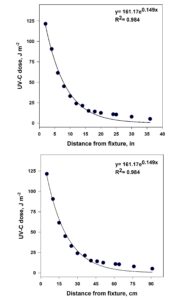
We also established a dark room in the seedling greenhouse to place the UV-light chamber in it and expose seedling before transferring them to the main growing area (Fig. 2).
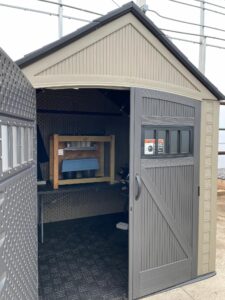
In October 2022, a preliminary test was conducted on lettuce plants that were planted in growing pots. This trial was carried out in a small scale to observe the operation of developed system before running the main trial. For this purpose, lettuce seeds were seeded in a transplant tray and kept for three weeks in the seedling greenhouse. Lettuce leaves were inoculated with powdery mildew spores 48 hours before treating the leaves with the UV-C light. Twelve infested lettuce seedlings were selected, six of them treated with UV-C light with an intensity of 140 J/M^2 for five seconds and six nontreated seedlings were served as the control. Seedlings were transplanted in growing pots including potting mix 24 hours post UV-light exposure. Three weeks after transplanting, we measured the fresh yield of lettuce. The preliminary results demonstrated that the plants treated with the UV-C light produced 45% more yield in comparison with non-treated plants (Fig. 3).
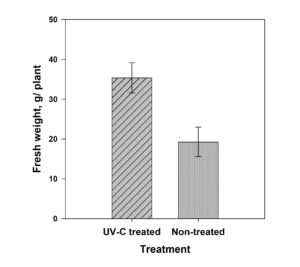
In January 2023, the second phase of this research was started with planting 1,500 lettuce seeds (variety Salanova) in seedling trays. A factorial arrangement based on randomized complete block (RCBD) was designed to implement two groups of treatment in a greenhouse:
A. UV-Light Treatments:
1) exposing seedlings to UV-C light (λ = 100-279 nm) for 5 seconds at the intensity of 150 J/M2
2) exposing seedlings to UV-B light (λ = 280-314 nm) for 10 minutes,
3) exposing seedlings to UV-C (for five seconds) and UV-B (for 10 minutes) together, and
4) untreated control (no exposure to UV light)
B. Application of MilStop
Treated plots Vs. untreated control plots (28 g of MilStop will be mixed with 2.5 gallons of water and the solution will be sprayed on plants twice with a two-week interval during the growing season of lettuce).
In January 2023, four rows of planting bed were prepared in a greenhouse, soil samples were taken for analysis. The schematic map of the trial and the layout of treatments are presented in figure 4.
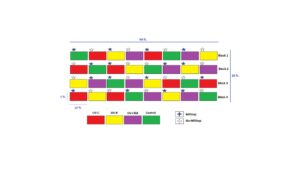
As described in the method section, a solution containing powdery mildew was prepared, and the spore count per milliliter was measured using a cytometer. The plants were then infested with these spores and treated with UV lights before being transplanted into the greenhouse (refer to Fig. 5). Thirty-five days after transplanting the seedlings in the greenhouse, we harvested the crop and evaluated the yield.
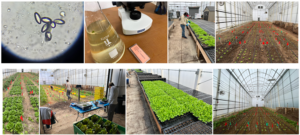
The combined results from three temporal replications of this trial demonstrate the significant effect of MilStop on lettuce yield. We observed a higher yield in all plots treated with the OMRI-listed fungicide compared to the untreated plots. The highest yield was observed in the plots treated with both MilStop and UV-C. On average, we measured approximately a 46% increase in yield in these plots compared to the non-treated control units. Figure 6 illustrates the crop yield among the various treatments.
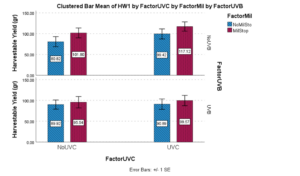
In addition to yield, the results also showcased the impact of treatments on powdery mildew infestation levels in the greenhouses. We graded the infestation levels of lettuce plants on a scale from zero to five, where zero indicated no signs of powdery mildew, and five indicated 100% coverage of the leaf surface by powdery mildew. The highest average powdery mildew infestation was observed in the control unit, averaging 2.17. This measure was notably lower, at 0.78 and 0.94 respectively, for plots treated with UV-C/MilStop and UV-C&B/MilStop (Fig. 7).
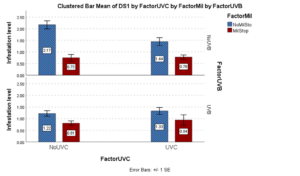
The observed increase in yield and reduced infestation levels in plots treated with UV-C and MilStop suggests that the application of these treatments can assist growers in achieving higher yields with improved marketability.
For this research, we conducted intensive outreach activities. These included integrating UV-light application as a new content for Rodale Institute Farmer and Veteran Training classes and presenting the results at several events listed below:
- Ghalehgolabbehbahani, A., Zinati, G., Dhakal, M. and Panday, D. Application of Ultraviolet Light and MilStop to Restrict Powdery Mildew Infestation in Organic Vegetable Greenhouses. ASA, CSSA & SSSA International Annual Meeting. St. Louis, MO, USA, Nov 01, 2023. (Oral presentation)
- Ghalehgolabbehbahani, A. 2023. Control pest and diseses in vegetable greenhouses with the use of UV-light. 2023 Tri-State IPM Workshop, 19&26 January 2023, VT, ME &NH.
- Ghalehgolabbehbahani, A., Panday. 2023. RIFT lecture on “specialty crop production and pest management in regenerative organic agroecosystems” in June 2023.
- Arash Ghalehgolabbehbahani and Dinesh Panday. Application of UV-light to control diseases in vegetable greenhouses. Rodale Institute 1st Annual Specialty Crop Symposium. Pocono, PA, August 23, 2023.
- Ghalehgolabbehbahan, A. 2023. Application of ultraviolet light and MilStop to restrict powdery mildew infestation in organic greenhouses. 2023 Northeast Integrated Pest Management Research Update Conference. November 16, 2023.(2023 Northeast Integrated Pest Management Research Update Conference - Day 2 - Northeastern IPM Center (northeastipm.org)).
- Dinesh, P., and A. Ghalehgolabbehbahani. 2023. Presented the UV-light project at the 2023-Rodale Institute field day. Number of attendees: ~500
In this research project, we assessed the impact of two types of UV-light and MilStop (an OMRI-listed fungicide) on powdery mildew infestation levels and lettuce yield in regenerative organic greenhouses. The ANOVA results revealed the significant effect of MilStop in controlling powdery mildew, resulting in higher yields in the greenhouses. Additionally, we observed a notable increase in yield in plots where plants were treated with UV-C light for five seconds at an intensity of 150 J/M^2. The highest yield and lowest infestation levels were achieved in plots where UV-C light was combined with the application of MilStop. These promising findings suggest that this integrated disease management approach could be implemented as a viable method to control powdery mildew in organic greenhouses where the use of chemical pesticides is prohibited. This approach not only aids growers in producing more marketable lettuce plants with reduced powdery mildew spores but also facilitates post-harvest handling processes. Although we did not observe a significant effect of UV-B light on lettuce yield, we hypothesized that UV-B light might change the crop's nutritional quality. To test our hypothesis, we sent samples to a lab for nutritional quality analysis. We are currently awaiting the results, which, upon receipt and analysis, will be integrated with the other findings described in this report for publication. The promising results led to the adoption of this integrated practice in Pocono Organics' lettuce production. We anticipate that more growers will begin using this tested method once we make the publication available to the public and conduct additional educational events aimed at disseminating information within the growers' community, which are already scheduled.
The next phase of this research involves combining the application of UV-light with other OMRI listed products and testing them across a wide variety of specialty crops in greenhouses. Additionally, our plans include integrating these forms of integrated pest and disease management with new technologies such as robotics and machine learning. This integration aims to develop user-friendly equipment for applying organically sound pest and disease management in agroecosystems, minimizing risks for human operators and workers.
Education & Outreach Activities and Participation Summary
Participation Summary:
For this research, we conducted intensive outreach activities. These included integrating UV-light application as new content for Rodale Institute Farmer and Veteran Training classes and presenting the results at several events listed below:
- Ghalehgolabbehbahani, A., Zinati, G., Dhakal, M. and Panday, D. Application of Ultraviolet Light and MilStop to Restrict Powdery Mildew Infestation in Organic Vegetable Greenhouses. ASA, CSSA & SSSA International Annual Meeting. St. Louis, MO, USA, Nov 01, 2023. (Oral presentation)
- Ghalehgolabbehbahani, A. 2023. Control pest and diseses in vegetable greenhouses with the use of UV-light. 2023 Tri-State IPM Workshop, 19&26 January 2023, VT, ME &NH.
- Ghalehgolabbehbahani, A., Panday. 2023. RIFT lecture on “specialty crop production and pest management in regenerative organic agroecosystems” in June 2023.
- Arash Ghalehgolabbehbahani and Dinesh Panday. Application of UV-light to control diseases in vegetable greenhouses. Rodale Institute 1st Annual Specialty Crop Symposium. Pocono, PA, August 23, 2023.
- Ghalehgolabbehbahan, A. 2023. Application of ultraviolet light and MilStop to restrict powdery mildew infestation in organic greenhouses. 2023 Northeast Integrated Pest Management Research Update Conference. November 16, 2023.(2023 Northeast Integrated Pest Management Research Update Conference - Day 2 - Northeastern IPM Center (northeastipm.org)).
- Dinesh, P., and A. Ghalehgolabbehbahani. 2023. Presented the UV-light project at the 2023-Rodale Institute field day. Number of attendees: ~500
The UV-light chamber established for this project was utilized to test and gather preliminary results on the application of UV-C light alongside two isolates of Trichoderma for managing soil microbial diseases in regenerative organic microgreen production. The findings from this research were compiled into a peer-reviewed article and submitted to a relevant journal:
- Ghalehgolabbehbahani, A. & Panday, D. 2023. Integrated Management Strategy for Soilborne Diseases in Regenerative Organic Microgreen Production Systems. Journal of Plant Diseases and Protection. Under review.
We have also started drafting a full peer reviewed paper from the results of this research. This will be submitted by June 2024.
An educational video lasting five to 10 minutes will also be prepared and posted on the Rodale Institute's website.
Learning Outcomes
The topics that we educated people on:
- Integrated approaches to control pest and diseases in organic agroecosystems
- OMRI listed products
- Organic and regenerative organic agriculture
- Environmental impact of chemical pesticides and fertilizers
- Application of UV-light to control microbial infestation in agricultural production systems
- Application of MilStop (an OMRI listed fungicide) to control fungal disease on vegetables
- National Organic Program (NOP)
- Soil and ecosystem health
- Agrobiodiversity
- Lettuce and microgreen production in regenerative organic greenhouses
- The importance of following the safety protocols on using UV light
Project Outcomes
Managing pest and diseases is one of the main challenges that organic growers face in their food production systems. Pocono Organic farmers manage ~45,000 sq.ft of certified regenerative organic greenhouse space. Since we started this project, they adopted application of MilStop and UV-light to control microbial diseases in a wide range of products. MilStop application has been using to control fungal diseases on different type of vegetables in Pocono Organic's greenhouses and fields.
Microgreens is well known as one of the most popular Pocono Organics products that can be used in Pocono Organics café or sold directly to wholesale and retail customers. Pocono Organic's farm manager reported the microbial diseases as the main restriction factor to scale up the microgreen production. Promising results collected from the preliminary test, encourage them to apply UV-C light to improve the yield of microgreen produced from broccoli seeds. Based on recommendations provided by Rodale Institute scientists, they integrated the application of UV-light with Trichoderma harzianum application. The preliminary data collected from the test illustrated that UV-light and T. harzianum have a significant effect on the yield of broccoli microgreen. Up to 200% increase in fresh yield was observed in the trays treated by T. harzianum and UV-light in comparison with the control units.
The key success of this project was identifying the problem and proposing an approach to solve it through collaboration with our partner growers. Involving the growers in the research and maintaining strong communication throughout the project facilitated its progress. One challenge we faced was the insufficient number of infested plants in the germination room for our research. To address this obstacle, we introduced powdery mildew spores extracted from the established lab culture to infest the plants. This adjustment in our methodology enabled us to address the research questions we had formulated. Based on the promising results observed, our team plans to conduct further investigations into the application of UV light across a wide range of crops and diseases. Interactions with growers and recognizing the needs within organic agroecosystems have motivated us to continue this research in the future. The next phase involves combining UV-light application with other OMRI-listed products and testing them across various specialty crops in greenhouse settings. Additionally, we aim to integrate these integrated pest and disease management strategies with emerging technologies like robotics and machine learning. This integration seeks to develop user-friendly equipment for implementing environmentally friendly pest and disease management practices in agroecosystems, thereby minimizing risks for human operators and workers.